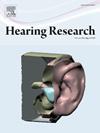中度老年性耳聋促进视听整合,但不利于唇读
IF 2.5
2区 医学
Q1 AUDIOLOGY & SPEECH-LANGUAGE PATHOLOGY
引用次数: 0
摘要
在听力学实践中,言语理解通常仅在听觉形态(安静或噪音中的言语)中进行评估。然而,在现实生活中,当听觉输入因噪音或听力损失(HL)而退化时,个体依赖辅助信号来增强语音感知。视听(AV)整合在改善嘈杂环境下的语音感知方面特别有效,但HL和衰老对这种能力的影响仍未得到充分研究。本研究旨在揭示HL和年龄对语音处理视觉方面的影响,包括单峰(唇读)和双峰(音像整合)。在65名年龄在50岁及以上的参与者中,听力从正常到中度HL(从4到63 dB HL),我们使用适应性程序测试了具有挑战性的听觉,视觉(唇读)和AV条件下的语音理解。AV增益(AV性能减去单独听觉性能)作为视听整合的衡量标准。使用多元线性回归和因果推理来解释HL和年龄之间的相对影响和潜在相互作用,我们的研究结果表明,轻度至中度HL不能改善单峰视觉处理,但可以改善AV增益。相反,衰老会对视觉语音处理产生负面影响,但不会直接影响AV增益。这些研究结果表明,轻度至中度HL增强了视觉和听觉语音线索的整合,在不影响视觉信息处理本身效果的情况下提高了视音频表现,而与年龄相关的视觉语音处理能力下降似乎并不影响整体视音频整合。我们认为这反映了一种中枢可塑性,在这种可塑性中,中度HL驱动高阶多模态水平的适应性变化,抵消视觉语音处理中与年龄相关的感觉衰退,以维持视音频语音整合。未来的研究应该探索这种可塑性在更严重的HL中是如何演变的。本文章由计算机程序翻译,如有差异,请以英文原文为准。
Moderate presbycusis boosts audio-visual integration, but not lip-reading
In audiological practice, speech comprehension is typically assessed in the auditory modality alone (speech in quiet or noise). However, in real-life communication when the auditory input is degraded - due to noise or hearing loss (HL) - individuals rely on ancillary signals to enhance speech perception. Audio-visual (AV) integration is particularly effective in improving speech perception in noisy environments, yet the influence of HL and aging on this ability remains underexplored.
This study aims to disentangle the effects of HL and age on visual aspects of speech processing, both unimodally (lip-reading) and bimodally (AV integration). In sixty-five participants aged 50 and older, with hearing abilities ranging from normal to moderate HL (from 4 to 63 dB HL), we tested speech comprehension in challenging auditory, visual (lip-reading) and AV conditions using an adaptive procedure. AV gain (AV performance minus Auditory-alone performance) served as a measure of audio-visual integration.
Using multiple linear regressions and causal inference to account for the relative impact and potential interactions between HL and age, our results show that mild to moderate HL does not improve unimodal visual processing but does improve AV gain. In contrast, aging negatively impacts visual speech processing but does not directly affect AV gain.
These findings suggest that mild to moderate HL enhances the integration of visual and auditory speech cues to improve AV performance without affecting the efficacy of the visual information processing itself, while age-related decline in visual speech processing does not appear to effect overall AV integration. We propose that this reflects a form of central plasticity, in which moderate HL drives adaptive changes at high-order multimodal levels, counterbalancing age-related sensory decline in visual speech processing to maintain AV speech integration. Future research should explore how this plasticity evolves with more severe HL.
求助全文
通过发布文献求助,成功后即可免费获取论文全文。
去求助
来源期刊

Hearing Research
医学-耳鼻喉科学
CiteScore
5.30
自引率
14.30%
发文量
163
审稿时长
75 days
期刊介绍:
The aim of the journal is to provide a forum for papers concerned with basic peripheral and central auditory mechanisms. Emphasis is on experimental and clinical studies, but theoretical and methodological papers will also be considered. The journal publishes original research papers, review and mini- review articles, rapid communications, method/protocol and perspective articles.
Papers submitted should deal with auditory anatomy, physiology, psychophysics, imaging, modeling and behavioural studies in animals and humans, as well as hearing aids and cochlear implants. Papers dealing with the vestibular system are also considered for publication. Papers on comparative aspects of hearing and on effects of drugs and environmental contaminants on hearing function will also be considered. Clinical papers will be accepted when they contribute to the understanding of normal and pathological hearing functions.
 求助内容:
求助内容: 应助结果提醒方式:
应助结果提醒方式:


